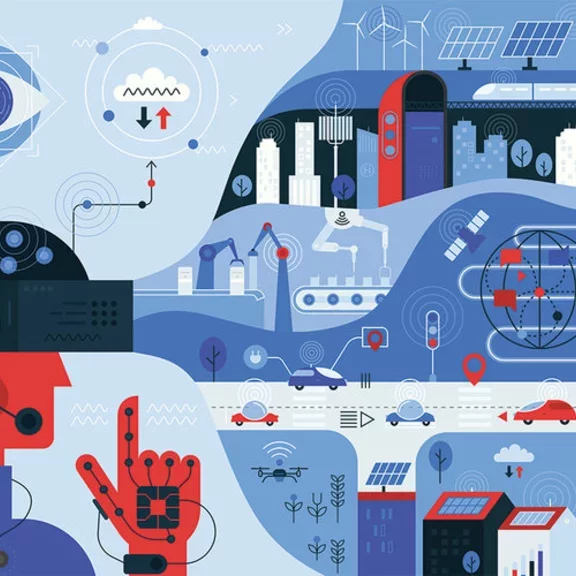5G technology: A revolution that is already happening
Published on March 04, 2021
6 minutes

With the new 5th-generation mobile networks currently being rolled out, watching films in high definition or enjoying lag-free face-time with family members while travelling will be just the start of a deep and lasting technological revolution. Real-time and reliable mobile broadband will soon allow countless internet connections, opening the doors to a range of revolutionary applications. All of which is good news for AirLiquide’s customers in the semiconductor industry providing the infrastructure for 5G.
For telecommunications experts, the high level of public and political interest in the 5G technology standard for broadband cellular networks is something of a novelty. After all, rolling out a new mobile network is nothing new: the clue is in the name “5G” – fifth generation. While 2G was barely noticed, 3G was popular with States (who auctioned bandwidth to generate windfalls), and 4G was primarily a topic of discussion for those who work in the technology sector, 5G has become a worldwide news item: geopolitics and trade wars, populism and conspiracy theories – the roll-out of this new generation of networks has garnered more attention than any previous.
So it can be all too easy to oversee that, for all it is still talked about as something which is about to happen, 5G is, in fact, already happening. Deployment began in 2019 and will be finished across developed economies in the mid-2020s. By 2025, around two thirds of the global population will be covered – and the full extent of transformation 5G entails will begin to become everyday reality.
The raft of 6,400 patents which make up the standard break down into three key technologies. Firstly, while existing mobile networks are in the 0-6 GHz spectrum, 5G will see them expand up to 52.6 GHz. This increased spectrum opens up higher frequencies, which enable down- and upload speeds into the tens of gigabytes per second at low latency (i.e. with no delay). Secondly, 5G antennas direct radio waves specifically at devices rather than simply broadcasting them in all directions. Called beamforming, this technology increases signal quality. Thirdly, massive MIMO antennas provide hundreds of antennas in one array, meaning that they can serve potentially thousands of devices at any one time – MIMO stands for “Multiple-Input, Multiple-Output”
As the increased spectrum allows for faster speeds and lower latency, beamforming ensures better signal quality, and MIMOs provide access to more devices with no interruptions, 5G opens up a range of possibilities which, until now, seemed like science fiction. The reason is that if you can guarantee high-speed connections without drops in connectivity, this doesn’t just make it easier for a smartphone user to watch videos of cats being cute or facetime their grandmother: it also allows machines to connect to each other and for safety-critical processes to be steered remotely.
The Internet of Things takes shape
Combined with outages and downtimes comparable to wired broadband connections, this opens up possibilities for using mobile networks which, until now, have been ruled out due to safety or reliability concerns.
In manufacturing, for instance, whole production lines can be connected and, as different parts of the system reliably communicate with each other in real time, whole new options for automation arise.
Automated driving becomes real
The same is true of automated driving applications, which are set to become standard far faster than may currently seem probable. After all, autonomous vehicles are already driving around factories and warehouses in environments where outside interference can be excluded – and where connectivity can be guaranteed. Once 5G vastly improves connectivity speeds and can provide truly reliable access across urban (and eventually rural) areas, there will be little reason not to deploy automated driving in a variety of contexts.
Remote medicine goes beyond video consultations
That, of course, is still some way off. Yet the infrastructure to enable futuristic-seeming scenarios like this is being installed – right now, as you read. So although telecommunications professionals might be somewhat surprised by the media debate around 5G, it is, in fact, perhaps genuinely surprising that public and political interest in the technology is not even stronger.
Interview with Benjamin Jurcik, Chief Technology Officer, World Business Line Electronics, Air Liquide
As CTO in Electronics, you keep a close eye on developments in technology. How will 5G change everyday life?
On a day-to-day level, there are some things 5G won’t change. Most people won’t notice whether they are using a good 4G connection or 5G on their smartphones, for instance. What 5G will do, though, is lead to a sustained expansion in the number of devices which can be connected and a marked increase in the quality of the connection. Simply put, if many more devices are connected, and the speed and reliability of connectivity is dramatically enhanced, many more applications become possible.
So are we talking about things like driverless cars?
Yes. In the medium-to-long term, expect to see automated driving and a wealth of other smart-city functionalities. We may also see surgeons remote-controlling robots for medical procedures, potentially opening up highly-specialised surgery to many more patients at lower cost and with less travel. These are the kind of things that are safety critical requiring the kind of rapid, reliable connectivity 5G will offer.
Before that, though, virtual and augmented reality will really take off: our semiconductors customers are already working with their customers to develop the chips needed for these kinds of applications. Also, smart factory applications are on the starting blocks: machines communicating with each other at factory level will lead to considerable enhancements in productivity, efficiency, and safety – and will be one of the first widespread 5G applications.
Will Air Liquide factories change, too?
They certainly will! As an industry leader, Air Liquide will be a consumer of 5G technologies throughout all of our business lines and will develop new applications exploiting the enhanced connectivity 5G offers – to improve our supply chain management, for example, or to increase safety and reliability.
The most tangible effect for Air Liquide’s activity, however, will be the increase in demand from our customers in the semiconductor industry. All semiconductor market segments (logic, analog, memory, and discrete) will be positively impacted by 5G deployment, and this will boost demand for all of the materials we supply to the semiconductor industry: Carrier Gas, Specialty Materials, Advanced Materials; there will also be strong demand for Equipment & Installations and services. This, of course, will come from a sector which is already booming – semiconductors grew right through the COVID-19 pandemic, for instance – and which will, with 5G deployment, receive additional growth impulses.




